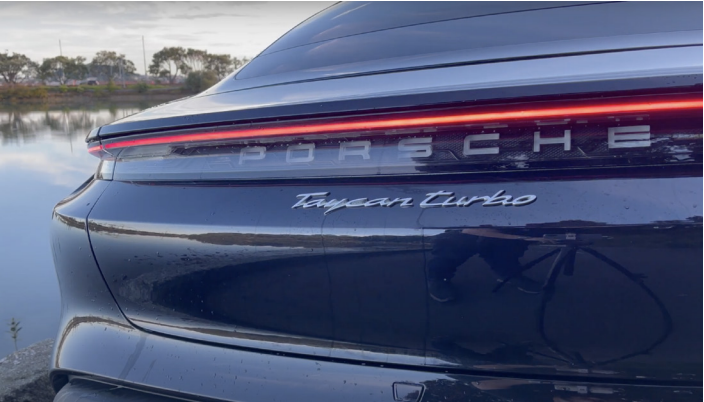
When the Porsche Taycan first became news, multiple comparisons were made with the current king of electric vehicle performance – the Tesla Model S.
Many noted their similar performance credentials, and Tesla pulled out a few tricks to beat the German in the numbers stakes. So let us deal with that first – yes in the 0-100kmh stakes the American is technically faster.
But does it really matter?
That was the question at the back of my mind as I started my short time with the ‘Turbo’ version of the sports sedan.
The Turbo is the middle model of the current Taycan range. It carries some impressive credentials – a 420km range, generates up to 500kW of overboost power in combination with launch control and accelerates to 100km/h in 3.2 seconds with a 260km/h top speed.
The Turbo starts at $289,900, a hefty step from the $203,900 Taycan, but a considerable saving on the Turbo S at $366,900.
For the same kind of performance from Tesla you need to spend at least $159,900 for a Long Range, though really the Plaid model, at $209,990 is a better match.
You do trade off some range opting for the Porsche, its battery is a 93.4kWh liquid-cooled unit. It is famous for being an 800Volt setup, which allows for 270kW charging should infrastructure allow.

Handily, the Taycan has charging ports on both sides, a type 2, with an 11kW maximum charge rate on one side, and the CCS2 port on the other, both forward of the front doors. A mobile charger is supplied as standard.
Standard equipment is as you would expect for a car of this standard – 20-inch wheels, metallic paint, front seat heating, 14-way electric comfort seats, auto-dimming mirrors and a BOSE Surround Sound system.
The Turbo also gets driving and comfort features like Porsche Dynamic Chassis Control (PDCC) Sport, four-zone advanced climate control and ambient lighting.
Models here gain a range of standard equipment in addition to worldwide standard specifications. All three model grades will be equipped with surround view, comfort access, lane change assist, lane keeping assist, adaptive cruise control, front seat ventilation, steering wheel heating, rear side airbags, electrically folding exterior mirrors, digital radio and privacy glazing.
Additional New Zealand standard equipment for the Taycan 4S includes 20-inch Taycan Sport Aero wheels, metallic paint, front seat heating, 14-way electric comfort seats, Auto-dimming mirrors as well as the BOSE Surround Sound system. Furthermore, the Taycan Turbo and Taycan Turbo S will also gain driving dynamic and comfort features like Porsche Dynamic Chassis Control (PDCC) Sport, four-zone advanced climate control and ambient lighting.
There is a decent sized boot, and a frunk large enough to take a compact carry-on case. So that is the on paper stuff, what is it like in real life? You can check out our review on the Auto Media Group Youtube channel for our experience.
In person, the Taycan has an incredibly sleek silhouette, long and low and with more of a Sportback shape than a saloon line to the body. The lighting design is impressive, with twin-level headlights and a full width LED rear lighting design that is absolutely stunning.
Lower yourself in, and the interior is surprisingly spacious. The driver is presented with a stylish sports wheel with a drive select dial, and a near-frameless digital dash cluster. The centre console features further LCD screens for infotainment (including Apple CarPlay), climate and vehicle control systems.

A full-glass roof on the test car added to an impressive feel of spaciousness.
The seats, front and rear, are comfortable and spacious. This truly meets ‘Grand Tourer’ requirements. It all feels premium and well screwed together compared to a Model S, but I would suggest – in the full-black interior test car – a little more could have been done to make it feel ‘special’.
Drop the Taycan into drive and the special arrives. This vehicle just blew me away with its combination of dynamics and power. For a start, even without using launch control, the Taycan throws you back firmly into your seat in a near neck-snapping way.
The Taycan uses a two-speed transmission on the rear motor to allow for extreme acceleration without compromising efficiency in cruise. There are Range, Normal, Sport and Sport Plus drive modes that do what you would expect in such a car, though most drivers will rarely need to go beyond Normal to get all the performance you will ever need on a Kiwi road.
Handling is sublime. This is the best handling EV I have experienced – it feels light at hand, responsive, and with near endless grip. While most EVs rely on the weight of the battery to convey a planted feeling, the Porsche simply feels like a sports car, the suspension tuned in a way that magically seems to hide the inertia effect of the battery weight to an impressive level.
This thing has so much grip that on Kiwi country roads you may end up a little sore from the g-forces it can pull. I did.
So yes the Taycan is brilliant. But does it live up to its price tag, especially in comparison to the competition?
I think it really does. While the Model S edges it in outright performance, there are few other categories where the Taycan can’t answer or beat it. Especially if you want a drivers car.








